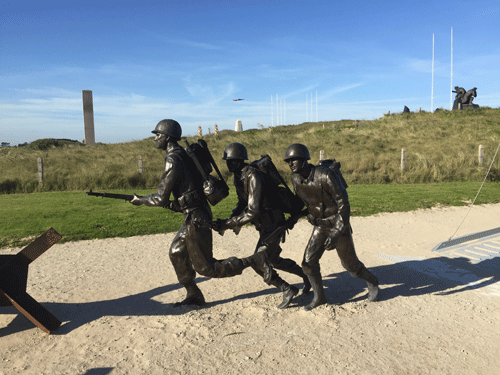
U.S. Memorial at Utah Beach
This past year, I was privileged to accompany my Father on a trip to the Normandy area of Northern France. The area is famous in history as the site for the D-Day Landings during World War II. The D-Day landings were the amphibious operations on June 6, 1944 of the Allied invasion of Normandy. The landings were the largest in history and began the liberation of occupied Europe from German control and eventually resulted in the Allied victory over Nazi Germany.
After renting a car at Charles de Gaulle Airport outside of Paris, we drove the 3-4 hour drive to the Normandy area. Our car was a diesel-powered Renault Captur. Diesel is cheaper than gasoline in France, and diesel-powered cars are much more common than here in the states.
Our first stop in Normandy was the La Cambe German war cemetery. While we had not initially planned on stopping there, it was along the side of the highway while we were driving through Normandy. The cemetery is located close to Bayeux, France and contains the graves of over 21,000 German military personnel who died in the Normandy area during World War II. It is maintained and managed by the German War Graves Commission. As you might imagine, a German war cemetery in Normandy is not the most popular place locally. A French Plaque at the Cemetery entrance best describes it; “The German Cemetery at La Cambe: In the same soil of France. It has been German since 1948 and contains over 21,000 graves. With its melancholy rigour, it is a graveyard for soldiers, not all of whom had chosen either the cause or the fight. They too have found rest in our soil of France.”
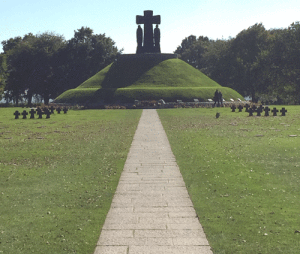
La Cambe German Cemetery in Normandy
The German personnel at La Cambe are buried two to a grave with one grave marker for both. Crews of tanks, planes, or other vehicles who died together are buried together. I noticed a majority of the identified personnel were around 18 to 24 years of age. I also noticed some grave markers were brown colored stone while others were black colored stone. Later research using some of the pictures I had taken of a few grave markers revealed that the brown grave markers were for regular German military personnel, while the black grave markers were for members of the Waffen-SS. The Waffen-SS was the military branch of the Nazi Party, of which some units were known for massacres of civilians and other atrocities during World War II.
Remains of soldiers from both sides continue to be found in the Normandy area to this day. A recent burial at La Cambe was Alfred Gartner, a German Paratrooper whose remains were found by a farmer trying to recover his cow from some hedges. Found along with his pistol, identification tags, and the remains of his uniform, he was buried alongside his comrades.
Driving through the Normandy area, it is impossible to miss the remains of the conflict. The many small villages, or “Communes” we drove through, you could see visible bullet holes and repaired artillery shell damage in walls and buildings. Along the roadways were many memorial plaques and statues. Some yards had World War II era cannons and other relics on display. German built bunkers and concrete covered gun emplacements were also a common sight.
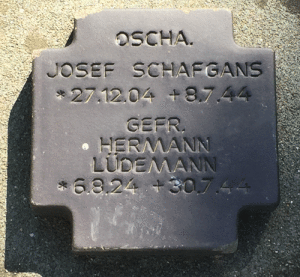
German Tombstone at La Cambe German Cemetery, the soldiers are buried two to a grave. Josef Schafgans was a Waffen-SS cameraman killed in Normandy.
The small town of Sainte-Mère-Église was our second stop. In the early hours of D-Day, paratroopers of the U.S. 82nd Airborne division landed there as the capture of the town was important for the Utah Beach landings. We visited the excellent Airborne Museum there which houses an actual C-47 airplane that dropped some of the paratroopers on D-Day and many other artifacts and displays. Some of the items displayed were donated by members of the 82nd Airborne after the war and relics that continue to be found to this day by the people in the area. In the middle of Sainte-Mère-Église a dummy paratrooper hangs from the church steeple commemorating the story of John Steele, who was an 82nd Airborne Paratrooper whose parachute got hung up on the church steeple during the landings. Dangling high above the ground for hours, he was eventually captured by the Germans, but later escaped and managed to rejoin his unit. John Steele died in 1969 a few weeks after the 25th anniversary of D-Day.
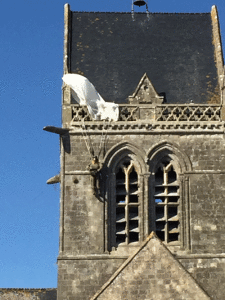
The church in Sainte-Mère-Église, a dummy paratrooper hangs from the church steeple commemorating the story of John Steele, who was an 82nd Airborne Paratrooper whose parachute got hung up on the church the morning of D-Day.
Utah Beach today looks much as it did in 1944, German bunkers, gun positions, and barbed wire can still be seen in the sand dunes. There is an excellent museum next to the beach that is built on top of a German command bunker. It contains artifacts and displays from the invasion, as well as relics recently found in the beach area. One excellent display outside of the museum was a concrete mortar pit that was recently excavated in the sand dunes. The range markings consisted of paintings of the terrain on the inside edges of the pit for reference. They were still in excellent condition 71 years later. The U.S. Memorial at Utah Beach consists of a landing craft, a tank, and some statues of U.S. soldiers charging the beach. Utah Beach today is peaceful and beautiful, unlike the morning of June 6, 1944.
We stayed our first night in Normandy at a nice bed and breakfast in the town of Carentan called the “Chambres d’Hôtes 101 ème Airborne”. If you have ever seen HBO’s excellent series “Band of Brothers”, you might recognize Carentan as one of the cities the 101st Airborne Division captured in the battle of Carentan, fought from 10-15 June 1944.
Part 2, which will cover our visit to Omaha Beach, Pointe du Hoc, the U.S. Cemetery in Normandy, and Arromanches, will be in next month’s issue.
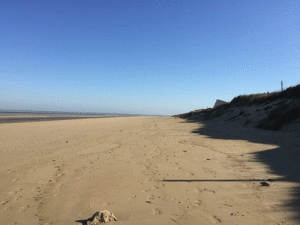
Utah Beach as it looks today
